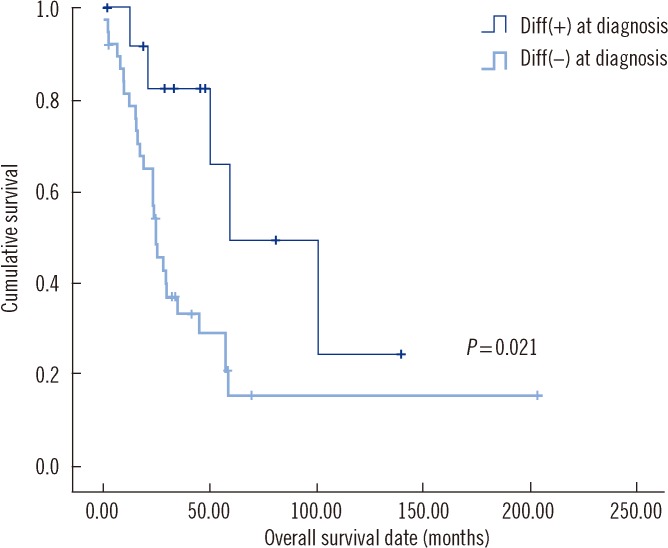Ann Lab Med.
2013 Mar;33(2):89-96. 10.3343/alm.2013.33.2.89.
Presence of Differentiating Neuroblasts in Bone Marrow is a Favorable Prognostic Factor for Bone Marrow Metastatic Neuroblastoma at Diagnosis
- Affiliations
-
- 1Department of Laboratory Medicine, University of Ulsan College of Medicine and Asan Medical Center, Seoul, Korea. cjpark@amc.seoul.kr
- 2Department of Laboratory Medicine, Ilsan Paik Hospital, Inje University College of Medicine, Goyang, Korea.
- 3Department of Pediatrics, University of Ulsan College of Medicine and Asan Medical Center, Seoul, Korea.
- KMID: 1781306
- DOI: http://doi.org/10.3343/alm.2013.33.2.89
Abstract
- BACKGROUND
The prognostic impact of the presence of differentiating neuroblasts in bone marrow (BM) remains unclear in BM metastatic neuroblastoma (NB). We aimed to identify the prognostic impact of differentiating neuroblasts in BM at diagnosis and after chemotherapy.
METHODS
A total of 51 patients diagnosed with BM metastatic NB at Asan Medical Center between January 1990 and July 2005 were enrolled. BM histology and laboratory data along with overall survival (OS) were compared with regard to the differentiation status of neuroblasts in BM at diagnosis and after chemotherapy.
RESULTS
Among the 51 patients, 13 (25.5%) exhibited differentiating neuroblasts in BM at diagnosis and 17/51 (33.3%) exhibited them after chemotherapy. The only significant difference among patient groups was the improved OS in patients with differentiated neuroblasts in BM at diagnosis (P=0.021). In contrast, the differentiation status of neuroblasts in BM after chemotherapy did not affect OS (P=0.852).
CONCLUSIONS
Our study is the first report describing the presence of differentiating neuroblasts in BM. The presence of differentiating neuroblasts in BM at diagnosis may be a favorable prognostic factor for patients with BM metastatic NB; however, the same phenomenon after chemotherapy is irrelevant to prognosis.
MeSH Terms
-
Adolescent
Antineoplastic Combined Chemotherapy Protocols/therapeutic use
Bone Marrow/*pathology
Bone Marrow Cells/*cytology
Bone Marrow Neoplasms/*diagnosis/secondary
Cell Differentiation
Child
Child, Preschool
Female
Humans
Infant
Karyotyping
Male
Neoplasm Grading
Neuroblastoma/*diagnosis/drug therapy/pathology
Prognosis
Survival Analysis
Young Adult
Figure
Reference
-
1. Shimada H, Ambros IM, Dehner LP, Hata J, Joshi VV, Roald B. Terminology and morphologic criteria of neuroblastic tumors: recommendations by the International Neuroblastoma Pathology Committee. Cancer. 1999; 86:349–363. PMID: 10421272.2. Peuchmaur M, d'Amore ES, Joshi VV, Hata J, Roald B, Dehner LP, et al. Revision of the International Neuroblastoma Pathology Classification: confirmation of favorable and unfavorable prognostic subsets in ganglioneuroblastoma, nodular. Cancer. 2003; 98:2274–2281. PMID: 14601099.3. Howman-Giles R, Shaw PJ, Uren RF, Chung DK. Neuroblastoma and other neuroendocrine tumors. Semin Nucl Med. 2007; 37:286–302. PMID: 17544628.
Article4. Brodeur GM, Seeger RC, Barrett A, Berthold F, Castleberry RP, D'Angio G, et al. International criteria for diagnosis, staging, and response to treatment in patients with neuroblastoma. J Clin Oncol. 1988; 6:1874–1881. PMID: 3199170.
Article5. Maris JM, Hogarty MD, Bagatell R, Cohn SL. Neuroblastoma. Lancet. 2007; 369:2106–2120. PMID: 17586306.
Article6. Haas D, Ablin AR, Miller C, Zoger S, Matthay KK. Complete pathologic maturation and regression of stage IVS neuroblastoma without treatment. Cancer. 1988; 62:818–825. PMID: 3293764.
Article7. Iwanaka T, Yamamoto K, Ogawa Y, Arai M, Ito M, Kishimoto H, et al. Maturation of mass-screened localized adrenal neuroblastoma. J Pediatr Surg. 2001; 36:1633–1636. PMID: 11685689.
Article8. McLaughlin JE, Urich H. Maturing neuroblastoma and ganglioneuroblastoma: a study of four cases with long survival. J Pathol. 1977; 121:19–26. PMID: 874625.
Article9. Rozmus J, Langer M, Murphy JJ, Dix D. Multiple persistent ganglioneuromas likely arising from the spontaneous maturation of metastatic neuroblastoma. J Pediatr Hematol Oncol. 2012; 34:151–153. PMID: 22052163.
Article10. Eklof O, Sandstedt B, Thönell S, Ahström L. Spontaneous regression of stage IV neuroblastoma. Acta Paediatr Scand. 1983; 72:473–476. PMID: 6880739.11. Lonergan GJ, Schwab CM, Suarez ES, Carlson CL. Neuroblastoma, ganglioneuroblastoma, and ganglioneuroma: radiologic-pathologic correlation. Radiographics. 2002; 22:911–934. PMID: 12110723.12. Schmidt ML, Lukens JN, Seeger RC, Brodeur GM, Shimada H, Gerbing RB, et al. Biologic factors determine prognosis in infants with stage IV neuroblastoma: A prospective Children's Cancer Group study. J Clin Oncol. 2000; 18:1260–1268. PMID: 10715296.
Article13. Bagatell R, Rumcheva P, London WB, Cohn SL, Look AT, Brodeur GM, et al. Outcomes of children with intermediate-risk neuroblastoma after treatment stratified by MYCN status and tumor cell ploidy. J Clin Oncol. 2005; 23:8819–8827. PMID: 16314642.
Article14. Tornóczky T, Semjén D, Shimada H, Ambros IM. Pathology of peripheral neuroblastic tumors: significance of prominent nucleoli in undifferentiated/poorly differentiated neuroblastoma. Pathol Oncol Res. 2007; 13:269–275. PMID: 18158560.
Article15. Ogita S, Tokiwa K, Arizono N, Takahashi T. Neuroblastoma: incomplete differentiation on the way to maturation or morphological alteration resembling maturity? Oncology. 1988; 45:148–152. PMID: 3368191.
Article16. Ben Arush MW, Ben Itzhak O, Yossilevski G, El Hasid R, Postovsky S, Israel O. Neuroblastoma maturation by [131I] metaiodobenzylguanidine in chemoresistant neuroblastoma. Med Pediatr Oncol. 1999; 33:418–419. PMID: 10491557.17. Reynolds CP, Matthay KK, Villablanca JG, Maurer BJ. Retinoid therapy of high-risk neuroblastoma. Cancer Lett. 2003; 197:185–192. PMID: 12880980.
Article18. Calvo W, Forteza-Vila J. Schwann cells of the bone marrow. Blood. 1970; 36:180–188. PMID: 5427453.
Article




